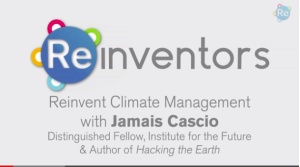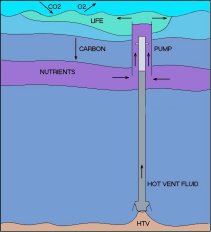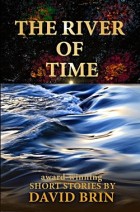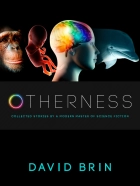On June 18 I joined a blue ribbon panel (via Google Hangout) on the topic of Reinventing Climate Management, led by scenario thinker Jamais Cascio, author of the book Hacking the Earth: Understanding Geoengineering. He moderated a terrific group of scientists and other innovators (plus me… for comic relief I guess) wrestling with this issue, joined by visitors from the web with questions and ideas.
 Managing the climate in the face of global warming is a wicked problem that requires getting almost every independent nation to coordinate. What would a system of global governance look like that’s up to the true challenges ahead? And how do we start thinking about whether we need to take more desperate steps in the form of geoengineering?
Managing the climate in the face of global warming is a wicked problem that requires getting almost every independent nation to coordinate. What would a system of global governance look like that’s up to the true challenges ahead? And how do we start thinking about whether we need to take more desperate steps in the form of geoengineering?
I came away from the discussion convinced, yet again, that some things merit much closer examination and experimentation. Out of all of the ideas that have been raised for either removing carbon from the atmosphere or reducing the sunlight that feeds the greenhouse, only one would attempt to emulate nature’s own process for removing CO2, the way by far the largest amount has already been removed — through chemical and biological sequestration in the open ocean. That proposal is Ocean Fertilization.
Yes, yes we have all read about silly, half-baked “experiments” in which poorly instrumented boats dumped tons of iron dust into ocean currents. These created plankton blooms, all right, but also questionable after-effects. They did not get very good press. And they poisoned the well – so to speak – for more intelligent proposals that would more closely emulate what Nature, herself does.
 And if anyone gets tentative rights to “speak for Mother Nature” it would be James Lovelock, author of the Gaia hypothesis. With Chris Rapley, director of the Science Museum in London, Lovelock proposed trying an option that would place vertical pipes some 200 meters long in the sea to pump nutrient-rich water from depth to the surface, thus enhancing the growth of algae in the upper ocean. The algae, which are key in transporting carbon dioxide to the deep sea and producing dimethyl sulphide involved in the formation of sunlight-reflecting clouds, should help to prevent further warming. According to his note in Nature: “Although fertilizing the ocean with iron as a way of stimulating algal growth is being considered, the use of pipes to use the ocean’s existing nutrients as fertilizer is certainly novel.”
And if anyone gets tentative rights to “speak for Mother Nature” it would be James Lovelock, author of the Gaia hypothesis. With Chris Rapley, director of the Science Museum in London, Lovelock proposed trying an option that would place vertical pipes some 200 meters long in the sea to pump nutrient-rich water from depth to the surface, thus enhancing the growth of algae in the upper ocean. The algae, which are key in transporting carbon dioxide to the deep sea and producing dimethyl sulphide involved in the formation of sunlight-reflecting clouds, should help to prevent further warming. According to his note in Nature: “Although fertilizing the ocean with iron as a way of stimulating algal growth is being considered, the use of pipes to use the ocean’s existing nutrients as fertilizer is certainly novel.”
Well… novel? Except that ocean bi-layer nutrient mixing was shown to readers way back in my novel EARTH (1989). Our friend, The Economist’s Oliver Morton, wrote an extensive blog on the Lovelock/Rapely proposal, which may get funding from the Gates Foundation for preliminary research. And Morton fairly describes some of the critics, as well:
“The concept is flawed,” says Scott Doney, a marine chemist at WHOI. He says it neglects the fact that deeper waters with high nutrients also generally contain a lot of dissolved inorganic carbon, including dissolved CO2. Bringing these waters to the lower pressures of the surface would result in the CO2 bubbling out into the air.”
Well, then shouldn’t we look into it and find out?
 Might this concept be compatible with Nathan Myhrvold’s innovation… pumping warm surface water below the thermocline? As reported by Oliver Morton, the system would be something a bit like a floating paddling pool with a long pipe dangling down from its centre. Because there will be waves outside the pool but not inside, water will splash in over its edge but not out, and so the water level inside the pool is higher than the level outside the pool, providing the downward force. A company called Atmocean has in fact built prototype systems which aim to do it in almost exactly the opposite way to the Searete patents, by using wave power to pump cool water up, but the effect would be the same, spreading nutrients from below to where the sunlight is…
Might this concept be compatible with Nathan Myhrvold’s innovation… pumping warm surface water below the thermocline? As reported by Oliver Morton, the system would be something a bit like a floating paddling pool with a long pipe dangling down from its centre. Because there will be waves outside the pool but not inside, water will splash in over its edge but not out, and so the water level inside the pool is higher than the level outside the pool, providing the downward force. A company called Atmocean has in fact built prototype systems which aim to do it in almost exactly the opposite way to the Searete patents, by using wave power to pump cool water up, but the effect would be the same, spreading nutrients from below to where the sunlight is…
…exactly what happens in the world’s greatest fisheries, off Chile, the Grand Banks and Antarctica. Why do extra nutrients spur fecundity and ocean health in those places, but not in “dying seas” that suffer from eutrification (death by excess fertilizing runoff from agriculture), like the Gulf of Mexico, the Mediterranean and especially the Black Sea? Well… just look at them! The difference should be obvious to the eye. The choked seas do not “drain well.”
Let’s make a parallel. It is said that ninety percent of the oceans are “desert” realms where very little lives, because of lack of nutrients to feed a food chain… mostly the stuff that you find in “dirt.” Now turn back onto the continents. What do we sometimes do to make deserts bloom? Onland we irrigated, bringing water to soil. At sea the proposal is to bring “soil” to the water in a sense. (The mouths of most river systems are also generally fecund.)
Ah, you answer, but hasn’t irrigation been a mixed blessing, and often a downright curse? Yes! Our ancestors ruined the so-called “Fertile Crescent” by pouring river water over fields, allowing salts and toxic metals to accumulate until the land died. But this did not happen everywhere. Many regions — e.g. the Ganges valley and the Yangtze — have been heavily irrigated for thousands of years without suffering desertification. Again, the reason should be eye-obvious: Those river valleys had good drainage, allowing salts to be washed away by monsoons.
The Gulf Stream, the Antarctic Current, and the fisheries near Chile are not enclosed seas — they flow. So ocean fertilization experiments should start where strong currents can disperse the plankton blooms. So let’s try some of the more natural-like layer mixing or bottom stirring proposals. And let’s see if we can make another Grand Banks somewhere.
== Another concept ==
 A truly ambitious concept for ocean fertilization by layer mixing would go beyond those mentioned above. It would use pipes more than 1000 meters long and power them by planting the bottom end right atop an oceanic hydrothermal (volcanic) vent!
A truly ambitious concept for ocean fertilization by layer mixing would go beyond those mentioned above. It would use pipes more than 1000 meters long and power them by planting the bottom end right atop an oceanic hydrothermal (volcanic) vent!
A thousand meters? Atop a volcanic vent? Well… I think we should try some simpler mixing methods, first.
== More factors ==
Again, Oliver Morton (in private correspondence) explained why the first recourse in ocean fert has always been iron.: “Iron is interesting because its a *micro*nutrient. That gives it great stoichiometry — you can see in the literature estimates of C:Fe ratios of around 100,000:1, IIRC. That gets you a lot of C for a tonne of Fe. As I understood it you were suggesting mobilising phosphorous reserves in ocean sediments or deepwater. For phosphate fertilizaton the ratio is 106:1 — the ideal Redfield ratio of C to P in marine biomass. The practical ratio, given losses, would almost certainly be a lot less; for iron it is more than 10 times less. If that were true for macronutrient fertilization, you’d get only a few tonnes of C stored for every tonne of P mobilized. There have to be better ways of getting rid of a tonne of C than that. You might do better — 10 tonnes C, maybe 30? But that still means a vast mass-moving operation to work at the desired gigatonne C level, because you would have to mobiliza a lot of tonnes of sediment or bottom water to deliver one tonne of P. This is a very different and more extensive infrastructure than needed for iron fertilization.” (See Morton’s survey of geoengineering schemes in Nature: Climate Crunch: Great White Hope .)
 Wow. Okay. Look, I never doubted than iron fertilization was efficient, compared to ocean bottom stirring, or bi-layer mixing. What I maintain is that not enough attention has been paid to studying the most effective parts of the ocean – e.g. the Grand Banks and Chile and Antarctica — to determine if they are also big net carbon sinks, as well as fantastic fisheries. It does not seem to have occurred to anyone that there might be other places on Earth that have almost the right conditions and that might be tipped into similar fecundity with just a little help.
Wow. Okay. Look, I never doubted than iron fertilization was efficient, compared to ocean bottom stirring, or bi-layer mixing. What I maintain is that not enough attention has been paid to studying the most effective parts of the ocean – e.g. the Grand Banks and Chile and Antarctica — to determine if they are also big net carbon sinks, as well as fantastic fisheries. It does not seem to have occurred to anyone that there might be other places on Earth that have almost the right conditions and that might be tipped into similar fecundity with just a little help.
Instead, the reflex is to assume that all meddling is always bad, all the time. Indeed, the metaphor I used was irrigation and that was the very reflex. We all know what shortsighted irrigation did to the Fertile Crescent… and that metaphor makes us ignore the lessons of other watersheds that remained productive and healthy for 4000 years. Again, this is the main difference between Chile, Labrador, Antarctica… and the eutrophic dead zones in the Gulf of Mexico and Mediterranean and Black Sea.
To my knowledge, this consideration was not handled well in most of the iron experiments.
== More using natural forces: Solar Towers ==
Some great ideas have been around for a long time. Way back in 1989 I talked about desert solar towers that use temperature differentials to suck greenhouse-heated air past turbines, generating electricity for free. A test unit was built in Spain 10 years ago. Now plans are underway for a 2015 solar tower in Arizona of mammoth proportions.
== Climate Miscellany ==
Back to Oliver Morton again… his rather skeptical look at more geoengineering schemes, especially cloud-creation.
A fascinating survey of how past climate changes, especially in the 17th century, severely affected societies and people worldwide, in The Inevitable Climate Catastrophe by Geoffrey Parker on The Chronicle.
Some convincing charts about climate change. Plus see my earlier posting: Arguing with your crazy uncle about Climate Change.
Somebody go read this and review it for us here? The Age of Global Warming: A History by Rupert Darwall.
== Plus Science Miscellany! ==
With three terrestrial-mass planets in the habitable zone of this small, red star (they would all be tidal locked facing their sun), “the likelihood of one of them actually being habitable is tremendous.” Just 22 light years away.
Interstellar Visioneers and a limitless future: Read a review on Centauri Dreams of UCSB Professor W. Patrick McCray’s new book called The Visioneers: How A Group of Elite Scientists Pursued Space Colonies, Nanotechnologies and a Limitless Future on the lives of Gerard O’Neill and Eric Drexler, and how their innovative visions and research into space colonies and nanotechnologies transformed society — and shaped our future.
Anthropologists see evidence that developing the ability to throw well was a major evolutionary driver. Something that Bill Calvin hypothesized 20 + years ago in The Throwing Madonna: Essays on the Brain. Indeed, throwing is one of our many prodigious skills that made us formidable and scary, even discounting “intelligence.”
A fascinating (if highbrow) appraisal of the radical roots of the Enlightenment.
John Hodgman narrates a Cory Doctorow animated short about NSA spies.
== call my agent… quick! ==
 Past Brain Activation Revealed in Scans: What if experts could dig into the brain, like archaeologists, and uncover the history of past experiences? This ability might reveal what makes each of us a unique individual, and it could enable the objective diagnosis of a wide range of neuropsychological diseases. New research at the Weizmann Institute hints that such a scenario is within the realm of possibility: It shows that spontaneous waves of neuronal activity in the brain bear the imprints of earlier events for at least 24 hours after the experience has taken place.
Past Brain Activation Revealed in Scans: What if experts could dig into the brain, like archaeologists, and uncover the history of past experiences? This ability might reveal what makes each of us a unique individual, and it could enable the objective diagnosis of a wide range of neuropsychological diseases. New research at the Weizmann Institute hints that such a scenario is within the realm of possibility: It shows that spontaneous waves of neuronal activity in the brain bear the imprints of earlier events for at least 24 hours after the experience has taken place.















Hello colleagues, how is the whole thing, and what you
would like to say regarding this paragraph, in my view its in fact
amazing in favor of me.
Make It Funny ‘ Humour is often key to a successful video viral.
A date who is not interested in learning and growing intellectually
may not be able to keep up over the long haul.
What are some of your favorite moments of ‘Japaneseness’
in video games that you’d like to give a shout-out to.